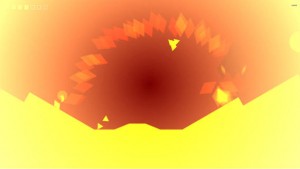Andrew Armstrong — of Fermenter Games — recently released upon the iOS scene an app that he described as Shadow of the Colossus meets Angry Birds meets Limbo, which he called David. (out now, $1.99). While each of the individual games that Andrew mentioned are indeed amazing, and an amalgamation of that triumvirate sounds like an awesome idea, I am here to say that David. is not the deserving successor to any of these. I am already fully aware — with all of the positive attention that David. has so far received — that this review isn’t going to make me particularly well liked, but I still feel that there are things which must be said all the same.
 David. is a minimalist game in the absolute strictest definition of the word, wherein you control a white square — whom goes around fighting evil masses of white angular shapes — all in the name of ‘good’. While there was always a special charm in the original low-res abstractions of yesteryear — which is why, despite our modern 3D marvels, the look refuses to go away — some misunderstand this to mean that blockier is better. Ignoring David.’s various game play issues — which I will be covering in detail — the graphics here are neither inspiring nor endearing, thus failing completely the entire point of abstraction.
David. is a minimalist game in the absolute strictest definition of the word, wherein you control a white square — whom goes around fighting evil masses of white angular shapes — all in the name of ‘good’. While there was always a special charm in the original low-res abstractions of yesteryear — which is why, despite our modern 3D marvels, the look refuses to go away — some misunderstand this to mean that blockier is better. Ignoring David.’s various game play issues — which I will be covering in detail — the graphics here are neither inspiring nor endearing, thus failing completely the entire point of abstraction.
The objective of the game — following a short tutorial level — is to tackle nine different boss only levels, which I guess is David.’s exclusive justification for the undeserved comparison with Shadow of the Colossus. Each of the first eight levels can either be attempted on an easy setting — wherein you are given a full health bar — or on a setting known only as ‘very’, where taking a single hit will equal instantaneous total failure. Assuming you manage to finish all eight stages on the ‘very’ (masochistic) setting, access to the ninth stage and final stage will then be opened up (however — due to the various control imperfections that I will be explaining next — don’t ever expect to see this level).
 David.’s default controls seem to start out normal enough at first — with two horizontal movement buttons on the left side of the screen, and a jump button on the other — but you’ll quickly discover that they have a slew of special problems. First off: the movement buttons are placed an awkward distance apart, when compared to other iOS games, such that you’re usually still hitting the same button whenever you try to switch directions. This level of directional imprecision is then further aggravated by the fact that all of the ground in David. seems to be made out of slippery ice, specifically of the old school video game variety, such that you tend to slide around for a bit before coming to a stop.
David.’s default controls seem to start out normal enough at first — with two horizontal movement buttons on the left side of the screen, and a jump button on the other — but you’ll quickly discover that they have a slew of special problems. First off: the movement buttons are placed an awkward distance apart, when compared to other iOS games, such that you’re usually still hitting the same button whenever you try to switch directions. This level of directional imprecision is then further aggravated by the fact that all of the ground in David. seems to be made out of slippery ice, specifically of the old school video game variety, such that you tend to slide around for a bit before coming to a stop.
The jump button itself — on the other hand — functions more like the swimming mechanic in Super Mario Bros (rather than something normally associated with leaping), such that endless mid-air jumps can be performed by rapidly tapping the screen. While this by itself would have been okay, the problem is that there’s a third input system wherein you are required to — all while both moving and jumping — actually touch the blocky hero. Successfully holding down on David will eventually cause him to charge up a powerful attack, which afterwards will fire forward — in a boomerang like arc — towards wherever you drag your finger over to next.
 Needless to say, it can be rather tricky to keep your hero up in the air — all while steering him in the correct direction — if you intend to simultaneously fire off his only weapon (which in David. will be an all too common occurrence). While there does exist an alternate control scheme, wherein your lateral motion is piloted entirely via tipping your iDevice, this doesn’t make accurately grabbing David any easier to accomplish. No matter which input method you choose to tackle David.’s nondescript evils with, you will ultimately be left struggling first and foremost with the game’s ill-conceived controls.
Needless to say, it can be rather tricky to keep your hero up in the air — all while steering him in the correct direction — if you intend to simultaneously fire off his only weapon (which in David. will be an all too common occurrence). While there does exist an alternate control scheme, wherein your lateral motion is piloted entirely via tipping your iDevice, this doesn’t make accurately grabbing David any easier to accomplish. No matter which input method you choose to tackle David.’s nondescript evils with, you will ultimately be left struggling first and foremost with the game’s ill-conceived controls.
While some other iOS games have managed to persevere despite being burdened with less than optimal controls, they usually managed to do so because the premise of their game play was more than the sum of its components. While each of the game’s boss fights do — to be fair — have their own gimmicks (none of which are very interesting), most of them simply boil down to playing endless keep away while awkwardly firing back. What is even more annoying is that these blocky demons — since they tend to follow you blindly around — usually just end up sitting on top of you, in the process trapping you underneath them for an effective one-hit kill (even if you weren’t playing on hard mode).
 Now I am fully aware, since most other reviewers seemed to be quite enamored from their personal time spent with David’s mission to eradicate all of the bad blocks, that I am alone here. However — after carefully perusing the other reviews — I noticed that some of them directly mentioned how they hadn’t even played the iOS version at all, even though their article was for a mobile website, instead having previewed the PC edition. Without a doubt I can easily imagine a realm where a keyboard and mouse combined would better manage David.’s action than the present iOS controls can, but I — unlike them — was instead given the actual iOS edition to play (and thus that is what I am reviewing).
Now I am fully aware, since most other reviewers seemed to be quite enamored from their personal time spent with David’s mission to eradicate all of the bad blocks, that I am alone here. However — after carefully perusing the other reviews — I noticed that some of them directly mentioned how they hadn’t even played the iOS version at all, even though their article was for a mobile website, instead having previewed the PC edition. Without a doubt I can easily imagine a realm where a keyboard and mouse combined would better manage David.’s action than the present iOS controls can, but I — unlike them — was instead given the actual iOS edition to play (and thus that is what I am reviewing).
Sadly — after much consideration — I am quite convinced that I still wouldn’t have been particularly enthused with this game even if the controls had been more serviceable, as David. is probably the perfect example of what not to do with minimalism. Limbo, Angry Birds, and Shadow of the Colossus — the three games which David claims to aspire to — are all of them titles where their very presentation was a core aspect of their total appeal. Although each of them were certainly good experiences, what would Angry Birds be without its whimsy — Shadow of the Colossus without it’s epic cinematography inspired set pieces — or Limbo without its moody portrayal and metaphorical underpinnings?
 The point of making a proper minimalist game, such as the ultra hard Super Hexagon, is to take a genre where the visuals were just getting in the way — not one where they were part of the main appeal — and then strip it down to the excellence at the very core of it all. Andrew Armstrong has — as of result of misunderstanding this entire premise — instead chosen games where stripping the pomp and circumstances erodes the very core of what they originally were, and then amalgamated only the deprecated husks of the originals. Therefore — even if better controls were to later be patched in — David. would still be little more than a game about squares flying around while shooting awkwardly at other squares, and not even a particularly interesting one at that.
The point of making a proper minimalist game, such as the ultra hard Super Hexagon, is to take a genre where the visuals were just getting in the way — not one where they were part of the main appeal — and then strip it down to the excellence at the very core of it all. Andrew Armstrong has — as of result of misunderstanding this entire premise — instead chosen games where stripping the pomp and circumstances erodes the very core of what they originally were, and then amalgamated only the deprecated husks of the originals. Therefore — even if better controls were to later be patched in — David. would still be little more than a game about squares flying around while shooting awkwardly at other squares, and not even a particularly interesting one at that.
Although Shadow of the Colossus itself is not available on the iOS — nor probably ever will be — Angry Birds and Limbo both are, and both of them are far superior uses of your time and money than joining David on his ill-explained mission of blocky frustration.
Verdict
Although claiming to be Angry Birds meets Shadow of the Colossus meets Limbo, David. manages to do so only in the most failingly bare bones way possible (and I’m still not entirely sure how it claims to be like Limbo at all). While I’m all for low-res graphics — as well as the occasional minimalist masterpiece, such as Super Hexagon — David. serves as a guide on how not to do any of these things. David. — by stripping the pomp and circumstance from games that were entirely about such things in part — is now just a collection of boring squares flying about, that is then further riddled by two utterly frustrating to use controls schemes. Whether you aim to be minimalist or not, you simply must have — if you intend to be soul crunchingly hard — control schemes that are far better than what is unfortunately found within David.


